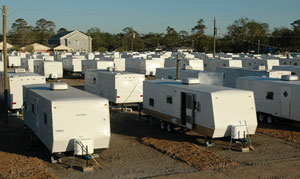f the US$18.3 billion that the Federal Emergency Management Agency (FEMA) had obligated itself to spend as of mid-October, $6.6 billion was targeted at housing, including a sizable amount meant for the purchase of manufactured housing. By late October some $2 billion in orders had been placed by FEMA for approximately 125,000 mobile homes, including major orders with Fleetwood, Monaco Coach and Champion Enterprises.

|
| The Ingalls-Wright Emergency Group Site in Pascagoula, Miss., is one part of an effort that as of Nov. 1 had placed 35,000 Mississippians into travel trailers or mobile homes, filling them at the rate of 400 per day.
Photo: FEMA/Mark Wolfe |
The effect on the RV, mobile home and manufactured housing manufacturing sector has been pronounced, says Bill Bradley, executive director of the Economic Development Corp. of Elkhart County in Indiana, a region widely recognized as the capital of the industry.
“Prior to the hurricanes, the RV industry was in a mini-slump, especially on the larger motor homes, though the towables and fifth wheels were doing fairly well,” he says. “But then Katrina and Rita hit, and we tried to alert as many companies as possible as to how to work with FEMA. We knew that, for better or worse, there would be demand for this product. Originally, FEMA went down and bought all the manufactured housing and RVs they could — our people had to restock the dealers down south.”
Bradley says one of the first companies that did something major was Gulf Stream — “they were actually shipping their product on rail to the Gulf Coast, two to three to a railcar bed.” Gulf Stream just last year completed a 35,000-sq.-ft. (3,252-sq.-m.) expansion of its towable-product facility in Nappanee, Ind., 15 minutes southwest of Goshen.
Since then, Forest River announced it would hire another 600 people, and Keystone, part of the Thor Group, has announced new hiring as well. Bradley says the labor pool is “not maxed out yet, but it’s getting close,” with unemployment hovering between 4 percent and 4.5 percent even before the bad weather.
In fact, fuel prices to the contrary, the industry has seen its share of new plants and expansions over the past couple of years.
“RV shipments have been on the rise over the past several years and we’ve heard that many RV manufacturers have indeed expanded their production facilities to keep up with consumer demand,” says Ken Sommer, director of media for the Recreational Vehicle Industry Association.
Some in the industry have been performing well enough to attract investment themselves: Forest River was recently purchased by investor Warren Buffett for $800 million. The company announced in late October that it was adding 600 workers to its payroll and three additional production facilities, including at least one in Goshen. The growth spurt follows an even bigger one in 2004: a $20-million investment that added 650,000 sq. ft. (60,385 sq. m.) of space in seven buildings, as well as 700 employees. The company’s total footprint is around 3 million sq. ft. (278,700 sq. m.).
Coachmen motorhome division Georgie Boy Manufacturing is transitioning production from a 98,720-sq.-ft. (9,171-sq.-m.) plant in Edwardsburg, Mich., to a new facility in Middlebury, Ind., that has 151,000 total sq. ft. (14,028 sq. m.) of manufacturing capacity. The move is part of the company’s “Intensive Recovery Plan” launched during the second quarter of 2005, which included disposing of assets in multiple locations and the entire Miller Buildings Systems commercial structures subsidiary. The Middlebury move is projected to cost $1.8 million, but should reap $5 million in operational improvements beginning in 2006.
But the hurricane effect is just beginning to occur.
“Like most Americans, we were shocked at the devastation wrought by Hurricanes Katrina and Rita on the Gulf Coast, and our hearts go out to all those affected by this tragedy,” said Coachmen Chairman and CEO Claire C. Skinner in late October. “Like many other companies, we have been presented with numerous opportunities to assist with the relief and reconstruction efforts. In our case this includes recreational vehicles as temporary shelters and modular homes as new permanent residences, as well as replacement commercial structures.”
In fact, the company’s RV Group received orders worth $30 million for 3,000 trailers to be delivered in the fourth quarter, in addition to what the company called “additional unconfirmed orders for a comparable number of units.” Coachmen’s Housing and Building Group had $4 million in orders for temporary structures, and looked for much more reconstruction opportunity to come in the residential arena because of “the rapid production times inherent with its modular construction techniques.”
Those techniques received endorsement at a November meeting organized by the manufactured housing industry to position factory-built homes as a major part of the reconstructed coast. Leland Speed, executive director of the Mississippi Development Authority, told participants that “factory-built homes offer a real opportunity” for putting people back in their own homes and that “stick-built homes aren’t even an option.”
As these manufacturers continue to churn out shelter for both the short-and long-term, there may be another sector that’s even busier: the makers of blue poly tarpaulins. One supplier, Tarps Plus in L.A., told the Palm Beach Post in late October that it had sold more than 2 million tarps since hurricane season began.